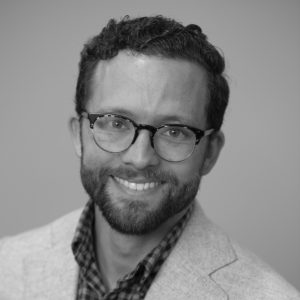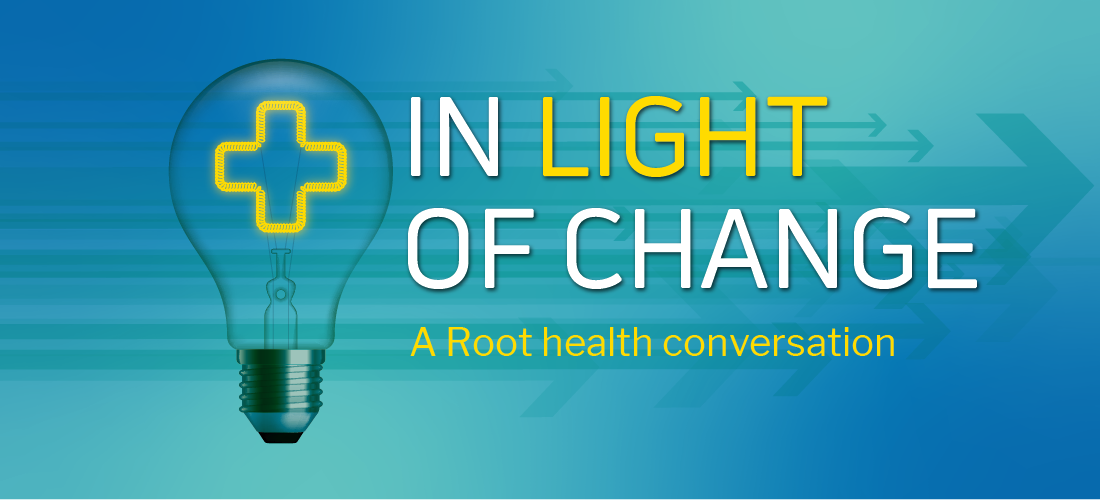Our Health industry expert and Managing Director Kalen Stanton has begun hosting a podcast, In Light of Change. In this podcast, Health industry thought-leaders and experts discuss what’s working in their field and how it relates to change leadership, care innovation, and more. Below is an abridged version from the debut episode featuring Chris Hamrick, founder of The Lorist Studio, discussing how to lead change with purpose.
Listen to the full conversation here.
What you’re about to read or hear:
- People are more afraid of the unknown than they are of change.
- Purpose is the path that keeps people moving forward together.
- You can make purpose into a Venn diagram.
- Milton Friedman was wrong.
- You need to start taking your patients to dinner.
Kalen: Welcome to In Light of Change and our very first exploration of leading change in healthcare’s unknown future. I’m really excited to have Chris Hamrick with me today, the founder of The Lorist Studio, who knows this path very well. Chris understands pioneering the unknown and doing so with purpose.
At Root, we work with a lot of large organizations that have very complicated change endeavors set before them. They have a hard time moving forward if they don’t first have the why – and a shared why. If we don’t have that clarity of purpose and direction from the why standpoint, then how much harder is it to envision what our desired future state will look like? Chris, I welcome your insight as we talk about change, knowing your purpose, and exploring the unknown of healthcare.
Chris: Purpose is really something that defines why we do things. When we look at the data, we see that purpose really helps drive a company forward – helps it grow, helps it sustain, helps it improve relationships not just with patients, but also among employee and medical staff.
I think we’re leading in a time of great change. People are okay with change. It’s the unknown they’re afraid of, and that’s where organizations get tripped up. Large, complex organizations trying to make massive changes and the people who are expecting to hear from their leaders are wanting to know: “What is it?”, “Why does it matter”, and “What’s in it for me?” quite frankly. That’s where purpose comes in. By embedding purpose in your strategy and decision-making, it changes your culture. It changes your operations. It changes everything and gets it away from the cold, process-driven world and gets it into really the true impact of human-centered design.
Kalen: That’s awesome. How do you find organizations today really being able to connect that purpose to business outcomes, as they are looking at the unknown and obviously trying to make a case for change?
 Chris: If you think of a Venn diagram with three circles (social, personal, and experience), purpose is right in the center of it. What we are doing is trying to create an experience as an organization that then produces personal value not only to the patients we’re trying to serve (or customers, if you’re not in healthcare), but the patients, their families, also the nurses and doctors, and even your environmental services people. We all go into healthcare for a reason, to help someone else.
Chris: If you think of a Venn diagram with three circles (social, personal, and experience), purpose is right in the center of it. What we are doing is trying to create an experience as an organization that then produces personal value not only to the patients we’re trying to serve (or customers, if you’re not in healthcare), but the patients, their families, also the nurses and doctors, and even your environmental services people. We all go into healthcare for a reason, to help someone else.
Fulfilling a Promise We Made to Ourselves
What we’re doing is really fulfilling a promise we have made to ourselves. There’s someone who needs care, and there’s someone who can provide care – someone who’s willing to do everything humanly and scientifically possible to help this other person. Yet there are barriers we’ve artificially created, processes and all these other things, that are important but maybe have gotten a little out of hand.
There’s a lot of benefit for defining purpose, but it starts with defining experience. Experience creates the memories we have. It’s our memories that frame the decisions we make. That’s a really important thing. This is when you make your decision based on your previous experiences, your knowledge, your lore. That’s why we’re The Lorist Studio; we study the lore. What is it that you know to be true? Where there are blanks, you get information from influencers. Understanding this really interesting dynamic of what do people know, what decisions are they likely to make, and who’s influencing that decision, that basic model is what gets into defining the experience.
Kalen: Right. What you’re describing, Chris, is – as you said in that Venn diagram – you have experiential value that is either overlapping or detached from that social value and personal value. All of that ultimately aligns with purpose. To me, this is one area (experience) where we’ve tried to go out and measure things in healthcare so we can manage it. But then we also have ways of measuring engagement internally with our teams. And we tend to rush to how can we measure each of them, it seems, before we define what that shared value is in the first place.
Chris: I want to reinforce what you just said: the idea of defining before measuring. I think going one step further is trying to connect the dots between those definitions because if we’re in a silo defining it and measuring, it’s not going to matter. We are just measuring, measuring, measuring. There’s no learning from it as effectively as it could be. What happens when we start defining and really starting to put purpose, which is really about intention? What is the intent of what we’re trying to do here? It opens up doors.
Milton Friedman Was Wrong
Milton Friedman was a great thinker, great mind in the 70s. But, he was wrong in his interview during that time when he said that the only purpose of business is to make a profit. Profit is scorekeeping. And we all make profit. Even not-for-profit hospitals have to make a profit – they just reinvest the proceeds differently than does a for-profit hospital. So we all have to drive return; we get that. [But] if you look at all the data sources on this, companies that embed purpose in their strategies – embed purpose in their decision making – outperform. Whether it’s the S&P 500, no matter what, they’re out performing in business results than everybody else. So there is a business benefit to this.
How do you get people to start talking about purpose? It starts with relationships and the ability to build relationships that create a sense of vulnerability. Very few [doctors, nurses, etc.] will tell you they’re practicing medicine in the way they thought they would when they went to medical school. They get absorbed into the process of care whether it’s signing off on billing and all sorts of other things that take time away from patients.
Really, it’s about getting them to be honest about what they want. I think one of the things that we don’t do enough is really listen to a patient. I’m not talking about listening to their symptoms, but what do they expect out of a relationship? What do they expect out of healthcare? What do they expect out of their insurance company?
Purpose Versus Mission and Vision
Kalen: What’s the difference in how you’re describing having a clear purpose and in what we would traditionally define as that mission and vision?
Chris: Great question. Mission and visions can reflect purpose, but purpose comes before mission and vision. Vision should describe a future state. It should be a goal, a pursuit. And it should reflect the purpose.
To create a vision statement that is based on purpose brings others into the equation. A mission, a lot of times, is how we’re going to get it done, right? If you think about whom you’re trying to serve, if you think about who is serving them in your organization, and that relationship and that shared value and that purpose, it changes the way you think about your vision and your mission.
I think the one thing that’s missing in a lot of organizations is we go so fast and things change so fast, and we continually look at our quarterly reports and how are we doing year over year, month over month, etc.
This is an opportunity to lift your head up and kind of look forward and look around. Those numbers on that piece of paper are produced by people, and that humanness of leadership is really essential, especially in healthcare. Because if nothing else, it has to be human. It has to be personal because it’s about life, living, and how well we live no matter where our journey with our health goes. And we have to really embrace that and live that from the beginning.
Kalen: Awesome. Well, thank you, Chris. Do you have any other takeaways or any ideas for us to get creative about navigating change?
Chris: You know, everybody’s plan is going to be a little bit different. But the starting point has to be really understanding and defining that sense of value, that sense of purpose, that “What is it?” we’re trying to share together.
And in healthcare, the natural thing that could happen is to actually listen to a nurse or a doctor and a patient together, maybe all three. And so we’ve all heard about “take your daughter to work” day – or son to work – and even had “take your dog to work” days. But why not just start with a program where you bring your patient to dinner? And it would be an opportunity to have leadership listen to stories about patients and nurses and why that specific relationship is so meaningful. So if you were really looking to define your purpose and really hone in on it, it would be a great place to start to listen to what those great relationships start like. But actually not just listening to one person. Listen to that shared relationship that people have, and you’ll find opportunities to really shape your sense of purpose – your purpose that can be embedded into your strategy from that.
Kalen: Well, that’s a great, great idea, Chris. I know we have a lot of leaders in the medical device space and pharmaceuticals and with our insurance providers that all have these stories, and so they ultimately have that share purpose as well in making lives better, enhancing lives, changing lives. I would love to see that happen, and thank you for inspiring us in that way.
Listen to the full conversation here.
What do you want to have a conversation about as you explore healthcare’s unknown future? Send Kalen (kstanton@RootInc.com) and the team a note here as we continue to build our calendar of exciting guests in the coming year.









